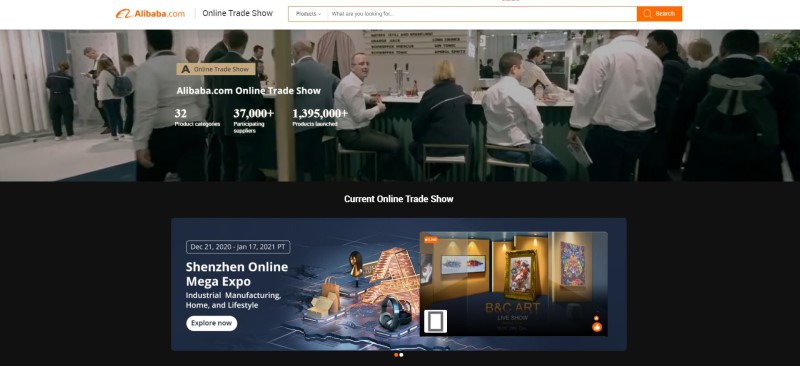Virtual trade shows: a complete guide

Trade shows have been valuable events for B2B sellers and buyers for many, many years. However, the spread of COVID-19 has forced many events that generally take place in physical venues to shift to virtual attendance only. Trade shows were one of these events.
Although it was a tricky transition in the first few months, the rapid digitalization and shift towards virtual trade shows have ended up being a blessing in disguise for many.
In this post, we’re going to review everything B2B buyers and sellers need to know about virtual trade shows. We will discuss what exactly virtual trade shows entail before comparing them to traditional in-person trade shows. From there, we will run through the benefits of virtual trade shows and discuss how SMBs can make the most of these online events.
We will wrap things up by discussing a few of the top virtual trade shows that are happening in 2021.
What is a virtual trade show?
Traditionally, a trade show is an event where sellers display and demonstrate their latest and greatest offerings, usually through sellers’ booths offered by trade show organizers. Buyers can come to test the products and services and connect with the sellers directly.
A virtual trade show takes this concept and makes it available online. Through online trade shows, sellers and buyers connect and talk about products and services online rather than in person.
Some virtual trade shows still use the “booth” model by using advanced technology to give attendees the ability to do a 3D walkthrough from their computers or smartphones.
An alternative method to using digital booths would be to have a sequence of live-streamed presentations from sellers, similar to webinars or conferences.
In-person vs. virtual trade shows
The obvious difference between in-person and virtual trade shows is how users attend. For in-person trade shows, guests must travel to the physical venue, but virtual trade shows are generally open for attendance to guests from anywhere in the world.
The valuable face-to-face connection that guests experience in an in-person event is not possible when attendance is totally virtual. Salespeople and exhibitors who thrive at networking events and similar environments may be skeptical of the digital approach, but they don’t need to be.
Luckily, this lack of face-to-face interaction is balanced out by the ability to reach larger quantities of people and increase brand exposure and increase visibility in that way. It is different but effective.
Virtual trade shows are also much cheaper for all parties involved, which is a win-win. The lower cost pair with the ability to attend from anywhere with access to the internet enhances the accessibility to trade shows. This is good for both buyers and sellers because it opens up opportunities on either end.

Types of virtual trade shows
There are virtual trade shows popping up in more industries as SMBs recognize the value of this sort of event.
Here are a few types of virtual trade shows that are popular right now:
- Niche product shows
- Raw materials and resource shows
- Property shows
- Car shows
- Food and beverage shows
- Technology shows
Thanks to the live streaming and webcasting technology that we have today, just about any type of trade show that you’d host in-person can be made virtual. There are next to no limits.

The benefits of virtual trade shows
Virtual trade shows are valuable to B2B buyers and sellers alike, which is why they will likely remain popular even after it is safe to travel and gather in large groups again.
Let’s take a look at how this type of event benefits businesses on each side of the trade.
Benefits for B2B sellers
Trade shows are more cost-effective and efficient than the in-person alternative. Since it costs less to host a virtual trade show, sellers may have access to lower participation fees.
Depending on how the virtual trade show is structured, an online trade show can help sellers reach every person who attends rather than just the ones that stop by their booths.
Another benefit of being online is that you can directly link to your website, inquiry forms, contact information, and other resources that will funnel viewers into your sales pipeline.
Since the B2B sales cycle is generally longer than the B2C sales cycle, using events like a virtual trade show is a great way to reach buyers and make lasting impressions with valuable content.
Sellers also have an easier time tracking the success of an online trade show. This is because there are tools (like Google Analytics) that can capture data and metrics that let them know how many people came to their sites from the trade show platform, and they can trace any actions that viewers take.
Benefits for B2B buyers
The primary benefit of virtual trade shows for B2B buyers is the ease of access. An SMB owner in Italy can attend a virtual trade show in Canada from the comfort of their home. This saves attendees potentially thousands of dollars in travel expenses.
Additionally, buyers can easily record information from sellers that have products that interest them. They can screenshot contact information or quickly type notes on their smartphones and computers.
Again, virtual events are generally more streamlined than in-person ones, so buyers can see a lot of stuff in a little bit of time. There is no waiting in line to see an exhibit or a certain product, which is nice for buyers.
Another perk is that buyers don’t have to wait to talk to a salesperson if they want more information or if they are ready to place an order. They can likely jump right over to the seller’s site or online storefront and find specs, pricing, or any additional information they need to know.
How does a virtual trade show work?
There are a few ways that trade shows can be set up, so there is some variation in the nature of virtual trade shows.
More advanced virtual trade shows use the “booth” approach through 3D technology. Exhibitors design on-brand, immersive booths much like the ones that they’d set up in a convention center or other venue. Attendees can browse from booth to booth to chat with sellers, test the product, and ultimately, find the seller that works for them.
The alternative to this would be a virtual trade show that gives each exhibitor a slotted time to present their offerings in a way that flows more like a virtual conference or webinar. This could all be live-streamed pretty easily.
In B2B international trade, buyers and suppliers prefer to meet face to face for serious business talk, more interaction, and strengthened relationships. Under the pandemic, it’s very difficult for them to remain the practice.
Virtual trade shows offer the solution to all the professional B2B customers to share the latest trend, exchange understandings and suggestions, check the detail of products and service with no barrier.
Thanks to the tech development, short video, live stream and 3D reality show, etc., online trade shows could well assist the suppliers to demonstrate the products, showcase the solution, discuss the production details even staying at home.
⭐How to prepare as a seller
Preparing for a virtual trade show requires a little bit more strategic planning than an in-person event would.
There are three steps to take as you prepare:
Step 1: take some time to think about goals moving forward. Also, identify how you want to stand out in your industry. You can do this by identifying current needs in your target market and use your virtual booth or presentation to establish how your product can meet that need.
Step 2: you should share relevant information on pricing, specs, delivery method, ordering process, and any other questions that your buyers frequently ask.
Since your buyers are likely the middlemen and not the people who will be using your products, it is also a good idea to present the benefits of buying from you over the competition. Add information on any guarantees, warranties, discounts, expedited shipping, and any other perks you can provide.
Step 3: you’re going to want to offer a “next step” for anybody who comes in contact with this content. Should buyers contact you directly, or is there a form for them to place an order? Can they request a custom quote, or are your products ready to ship? They need your direction if you want them to take your desired action.
⭐Tips for success as a seller
Sellers should strive to stand out against competitors at virtual trade shows in order to maximize success. Your virtual booth should have an enticing flair, and it should be easy for online attendees to navigate. Here are a few tips for you to get ready for the trade show:
Tip 1: Back to the essence of the trade show, buyers have strong interests in a new launch, new tech, or new trend. Sellers should prepare the key products you plan to introduce to buyers during the trade show. It is better if sellers even figure out specific tailor-made products for the trade show.
Tip 2: pay attention to the content preparation, e.g. video production or script preparation and rehearsal of lives stream, in order to have smooth communication online.
Tip 3: get the team ready. During the trade show, there’ll be more industry-professional buyers due to the specific promotion. Your team needs to be ready for the potential increased inquiries, because clear and accurate response is key for building up trust and cooperation between buyers and sellers.
Tip 4: create an on-brand experience. It is also valuable to incorporate anything that makes buying from you an easy decision. Use customer testimonials and reviews to build trust. Make the trade show attendees feel comfortable with your brand and products.
Tip 5: if possible, set up some sort of lead collection that gives you access to the email addresses of interested people. That way, you can follow up with attendees after the event has ended and begin to foster a relationship.
⭐Tips for success for event hosts
As a seller, you want to make sure that your event host is creating an event that will yield the greatest success to all parties involved. Since you are paying to be an exhibitor, you’ll want to make sure to get the desired return on investment.
One of the most important things that event hosts must do is to ensure that they are targeting the right audience for ticket sales. As a seller, confirm that the event’s target audience overlaps with your target audience.
There are two suggested ways that event hosts can spread the news of a virtual trade show to their audience: Eventbrite and Goldstar. These are two ticket-selling platforms that use a social media-like algorithm that brings users events that match their preferences and past searches.
Facebook is another great tool for event hosts who are looking to expand their reach.
The main thing to consider is where your ideal buyers are hanging out online. Event hosts should be promoting the trade show where potential attendees are looking for it.
Pros and cons of virtual trade shows
Although virtual trade shows have been helpful to many businesses, especially over the past year, this type of event does have a few minor setbacks.
Let’s take a look at the pros and cons of virtual trade shows.
Pros
- Online nature makes virtual trade shows more scalable as they open attendance to guests around the globe
- 24x7 exhibition, no time limit
- Faster paced, so you can cover a lot in a little bit of time
- Less setup time required
- More cost-effective for event planners (no need to rent a venue or vendors)
- More cost-effective for guests who would normally have to travel
- Safe for keeping physical distance to slow the spread of COVID-19
Cons
- No face-to-face interactions
- More difficult to make high-quality connections
- Takes a bit of technological know-how
- Requires a bit more preparation for exhibitors
The consensus
The consensus after weighing these pros and cons is that virtual trade shows are worth it for sellers and exhibitors to successfully reach new buyers.
There may be some limitations on personal interactions, but the volume of buyers that can come in contact with each virtual booth can maximize your brand’s reach.
The nature of an online trade show can also help sellers who are looking to expand globally. This is because there are no geographic limits on attendance that you could have participants from any continent.
While reviewing some upcoming trade shows in the B2B industry, we’ve found that some organizations plan to host both online and in-person events going forward in 2021. Although virtual trade shows grew in popularity due to the need for social distancing, it looks like they will stay around for years to come.
Upcoming virtual trade shows for 2021
Interested in attending a virtual trade show as either an exhibitor or a buyer? Here are a few popular online events that are coming up in 2021.
Alibaba.com Online Trade Shows
Alibaba.com serves as the world’s largest B2B marketplace with more than 14 million active buyers from over 190 countries and regions over the world. Alibaba.com also holds various online trade shows throughout the year.

There are 3 types of online trade shows in all:
- Comprehensive trade shows (EXPO) for all the categories.
- Category-specific trade shows, such as consumer electronics trade show and Alibaba.com x WeCosmoprof.
- Country/region-specific trade shows, such as the Japan Online Trade Show.
Alibaba.com Gold Suppliers with strong service quality and capabilities will be invited to the online trade shows, and usually, suppliers can gain a significant increase of exposure and inquires of their products from these trade shows.
For now, there is no extra charge for all the qualified suppliers, so it is completely free and serves as a great privilege for Gold Suppliers.
During the online trade show, there are several tools that can be used to enhance interaction for a better business experience. For example, live streaming, short videos, or other features are available for suppliers to use and to strengthen communication with global buyers.
Visibility to global buyers depends on the preference of buyers, which means according to buyers’ profiles, the system will recommend the most relevant suppliers to the buyers.
Watch the video of Zhi Yan and Jake from Wemb's Marketing, a Malaysian exporter, talking about their successful experience leveraging Alibaba.com live-streaming to drive sales and business growth.
NRF 2021 Retails BIG Show
National Retail Federation’s “Retail’s Big Show” is a webinar, conference, and virtual trade show that brings together a collection of industry leaders and suppliers to showcase the latest and greatest in retail.
The event is generally held in New York City, New York, but this year it will be an online event.
The dates of the event are January 17th through January 19th. The starting price to become an exhibitor at this virtual trade show is $4500, and the standard “admission” rate for retailers is $195. Retailers who register before January 6, 2021 may be eligible for a free pass to the event.
Learn more about this event at nrfbigshow.nrf.com.
Worldwide Online Show Spring 2021
The Worldwide Online Show Spring 2021 is being hosted by Worldwide’s group of independent retailers. It is being held from February 9th through February 11th.
Worldwide’s site does not currently provide any information on registration for attendees, but exhibitors can apply by logging into their Worldwide portal.
Final thoughts
Virtual trade shows have served as a great alternative to in-person events over the past year. They have helped keep things moving in the B2B world even though physical distancing has become a must.
Since these online events have proven to be successful and cost-effective, they will likely live on even the world goes back to life as we knew before COVID-19.
Become an Alibaba.com Gold Supplier will give you access to Alibaba.com Online Trade Shows with no extra cost. Your digital storefronts on Alibaba.com are also like 24/7 trade show booths that constantly display your product offerings, contact information, credentials, and more to millions of active buyers.
Register a seller account and start selling on Alibaba.com today!
Start your borderless business here
Tell us about your business and stay connected.
Keep up with the latest from Alibaba.com?
Subscribe to us, get free e-commerce tips, inspiration, and resources delivered directly to your inbox.















